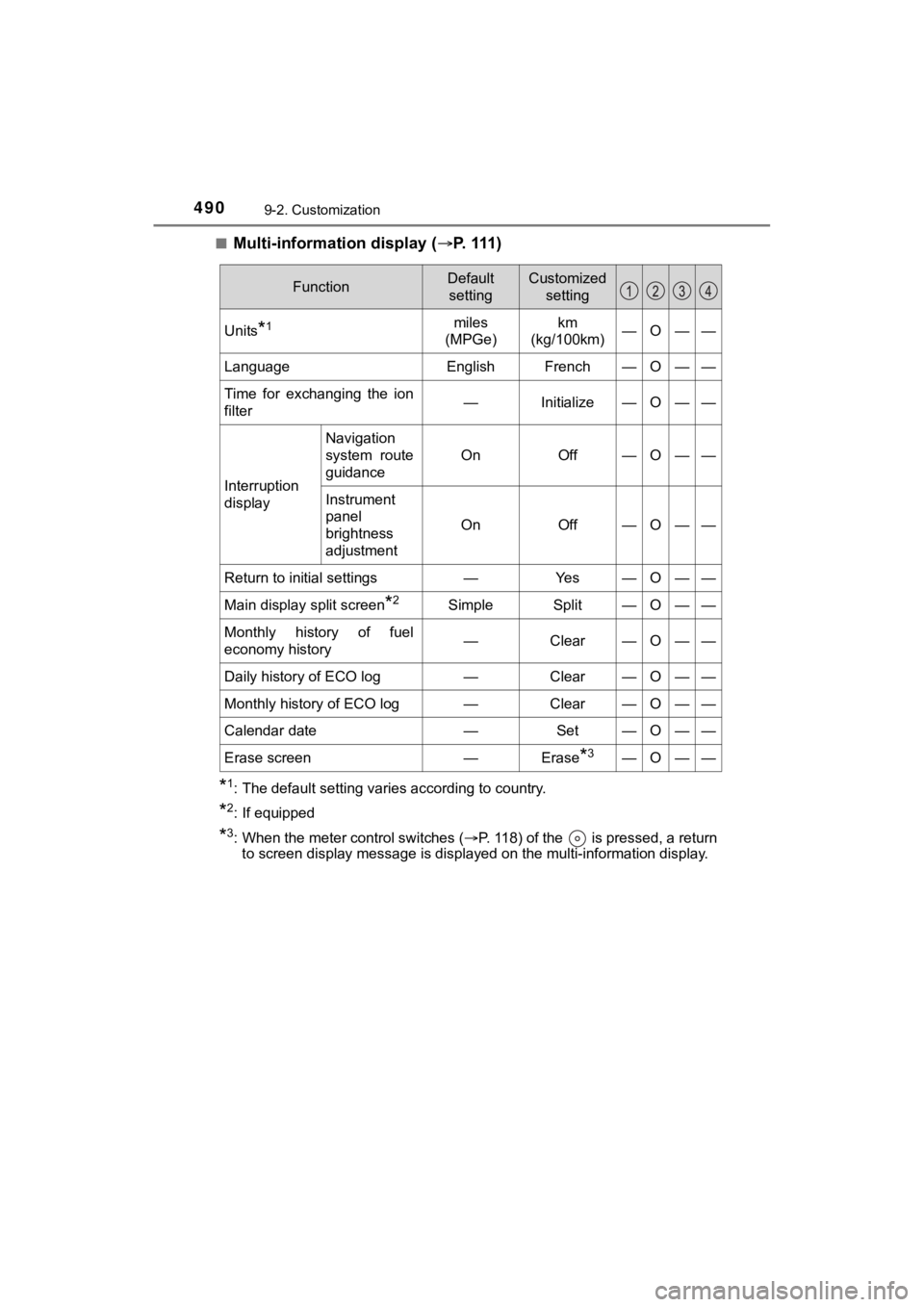ESP TOYOTA MIRAI 2020 (in English) Workshop Manual
[x] Cancel search | Manufacturer: TOYOTA, Model Year: 2020, Model line: MIRAI, Model: TOYOTA MIRAI 2020Pages: 528, PDF Size: 11.98 MB
Page 454 of 528

4548-2. Steps to take in an emergency
MIRAI_OM_USA_OM62073U
Make sure the “READY” indicator comes on. If the indicator does
not come on, contact your Toyota dealer.
Once the fuel cell system has started, remove the jumper cables in
the exact reverse order from which they were connected.
Close the exclusive jump starting terminal cover, reinstall the motor
cover and the fuse box cover to its original position.
Once the fuel cell system starts, have the vehicle inspected at your
Toyota dealer as soon as possible.
■ Starting the fuel cell system when the 12-volt battery is discharged
The fuel cell system cannot be started by push-starting.
■ To prevent 12-volt battery discharge
●Turn off the headlights and the audio system while the fuel cell system is off.
● Turn off any unnecessary electrical components when the vehicle is running
at a low speed for an extended period, such as in heavy traffic .
■ Charging the 12-volt battery
The electricity stored in the 12-volt battery will discharge gr adually even when
the vehicle is not in use, due to natural discharge and the dra ining effects of
certain electrical appliances. If the vehicle is left for a lon g time, the 12-volt
battery may discharge, and the fuel cell system may be unable to start. (The
12-volt battery recharges automatically while the fuel cell sys tem is operat-
ing.)
■ When the 12-volt battery is removed or discharged
● In some cases, it may not be possible to unlock the doors using the smart
key system when the 12-volt battery is discharged. Use the wire less remote
control or the mechanical key to lock or unlock the doors.
● The fuel cell system may not start on the first attempt after t he 12-volt bat-
tery has recharged but will start normally after the second att empt. This is
not a malfunction.
● The power switch mode is memorized by the vehicle. When the 12- volt bat-
tery is reconnected, the system will return to the mode it was in before the
12-volt battery was discharged. Before disconnecting the 12-volt battery,
turn the power switch off.
If you are unsure what mode the power switch was in before the 12-volt bat-
tery discharged, be especially careful when reconnecting the 12 -volt battery.
● If the 12-volt battery is depleted with the shift position in P , it will not be pos-
sible to shift the shift position other than P. In this case, the vehicle cannot
be towed without lifting both front wheels because the front wheels are
locked by the parking lock. ( P. 412)
8
9
10
Page 461 of 528

4618-2. Steps to take in an emergency
MIRAI_OM_USA_OM62073U
8
When trouble arises
Start the fuel cell system and turn the air conditioning system on
to check that the radiator coo ling fans operate and to check fo r
coolant leaks from t he radiator or hoses.
The fans operate when the air conditioning system is turned on immedi-
ately after a cold start. Confirm that the fans are operating b y checking
the fan sound and air flow. If it is difficult to check these, turn the air con-
ditioning system on and off repeatedly.
(The fans may not operate in freezing temperatures.)
If the fans are not operating:
Stop the fuel cell system immed iately and contact your Toyota
dealer.
If the fans are operating:
Have the vehicle inspected at the neare st Toyota dealer.
WARNING
■When inspecting under th e hood of your vehicle
Observe the following precautions.
Failure to do so may result in serious injury such as burns.
● If steam is seen coming from under the hood, do not open the ho od until
the steam has subsided. The motor compartment may be very hot.
● After the fuel cell system has been turned off, check that the “READY”
indicator is off.
When the fuel cell system is operating, the cooling fans may suddenly
operate even if the fuel cell system stops. Do not touch or app roach rotat-
ing parts such as the fans, which may lead to fingers or clothing (espe-
cially a tie, a scarf or a muffler) getting caught, resulting i n serious injury.
● Do not loosen the coolant reservoir caps or radiator cap, while the fuel cell
system and radiator are hot.
High temperature steam or coolant could spray out.
6
7
Page 477 of 528

4779-1. Specifications
MIRAI_OM_USA_OM62073U
9
Vehicle specifications
■Temperature A, B, C
The temperature grades are A (the highest), B, and C, representing
the tire’s resistance to the ge neration of heat and its ability to dissi-
pate heat when tested under contr olled conditions on a specified
indoor laboratory test wheel.
Sustained high temperature can c ause the material of the tire to
degenerate and reduce tire life, and excessive temperature can lead
to sudden tire failure.
Grade C corresponds to a level of performance which all passeng er
car tires must meet under the Fe deral Motor Vehicle Safety Stan-
dard No. 109.
Grades B and A represent higher levels of performance on the labo-
ratory test wheel than the minimum required by law.
Warning: The temperature grades of a tire assume that it is pro perly
inflated and not overloaded.
Excessive speed, underinflation, or excessive loading, either sepa-
rately or in combination, can c ause heat buildup and possible t ire
failure.
Page 490 of 528

4909-2. Customization
MIRAI_OM_USA_OM62073U■
Multi-information display (
P. 111)
*1: The default setting varies according to country.
*2: If equipped
*3: When the meter control switches ( P. 118) of the is pressed, a return
to screen display message is displayed on the multi-information display.
FunctionDefault
settingCustomized setting
Units*1miles
(MPGe)km
(kg/100km)—O——
LanguageEnglishFrench—O——
Time for exchanging the ion
filter—Initialize—O——
Interruption
display
Navigation
system route
guidance
OnOff—O——
Instrument
panel
brightness
adjustment
OnOff—O——
Return to initial settings—Ye s—O——
Main display split screen*2SimpleSplit—O——
Monthly history of fuel
economy history—Clear—O——
Daily history of ECO log—Clear—O——
Monthly history of ECO log—Clear—O——
Calendar date—Set—O——
Erase screen—Erase*3—O——
Page 503 of 528

503
MIRAI_OM_USA_OM62073U
10
For owners
AVERTISSEMENT
■Précautions avec les coussins gonflables SRS
Respectez les précautions suivantes concernant les coussins gon flables
SRS.
À défaut, des blessures graves, voire mortelles, pourraient s’ensuivre.
● Le conducteur et tous les passagers à bord du véhicule doivent porter leur
ceinture de sécurité correctement.
Les coussins gonflables SRS sont des dispositifs de protection complé-
mentaires aux ceintures de sécurité.
● Le coussin gonflable SRS conducteur se déploie avec une puissance con-
sidérable et peut occasionner des blessures graves, voire morte lles, nota-
mment lorsque le conducteur se trouve très près du coussin gonf lable.
L’autorité fédérale chargée de la sécurité routière aux États-U nis, la
NHTSA (National Highway Traffic Safety Administration) conseill e:
Sachant que la zone de danger pour le coussin gonflable conduct eur se
trouve dans les premiers 2 à 3 in. (50 à 75 mm) du déploiement, placez-
vous à 10 in. (250 mm) du coussin gonflable conducteur pour gara ntir
une marge de sécurité suffisante. Cette distance est à mesurer entre le
moyeu du volant de direction et le sternum. Si vous êtes assis à moins de
10 in. (250 mm), vous pouvez changer votre position de conduite de plu-
sieurs façons:
• Reculez votre siège le plus possible, tout en continuant à pou voir
atteindre confortablement les pédales.
• Inclinez légèrement le dossier du siège. Bien que la conception des véhicules varie, de nombreux conduct eurs
peuvent atteindre la distance de 10 in. (250 mm), même avec le s iège
du conducteur tout en avant, simplement en inclinant légèrement le
dossier du siège. Si vous avez des difficultés à voir la route après avoir
incliné votre siège, utilisez un coussin ferme et antidérapant pour vous
rehausser ou, si votre véhicule est équipé du réglage en hauteu r du
siège, remontez-le.
• Si votre volant de direction est réglable, inclinez-le vers le bas. Cela
vous permet d’orienter le coussin gonflable vers votre buste plutôt que
vers la tête et le cou.
Le siège doit être réglé selon les recommandations de la NHTSA ci-des-
sus, tout en conservant le contrôle des pédales et du volant, e t la vue des
commandes au tableau de bord.
Page 507 of 528

507
MIRAI_OM_USA_OM62073U
10
For owners
AVERTISSEMENT
■Précautions avec les coussins gonflables SRS
● Évitez de faire subir des chocs ou des pressions excessives aux parties
renfermant les composants des coussins gonflables SRS.
En effet, cela pourrait entraîner un mauvais fonctionnement des coussins
gonflables SRS.
● Ne touchez aucun composant du système immédiatement après le
déclenchement (déploiement) des coussins gonflables SRS, car ils sont
alors encore très chauds.
● Si vous avez des difficultés à respirer après le déploiement des coussins
gonflables SRS, ouvrez une porte ou une vitre pour faire entrer de l’air
frais, ou bien descendez du véhicule si cela ne présente pas de danger.
Retirez tout résidu dès que possible afin d’éviter d’éventuelles irritations
de la peau.
● Si les parties renfermant les coussins gonflables SRS, telles q ue la garni-
ture centrale du volant de direction et les garnitures de montants avant et
arrière, apparaissent abîmées ou craquelées, faites-les remplac er par
votre concessionnaire Toyota.
● Ne rien poser sur le siège du passager avant, comme un coussin par
exemple. Cela a pour conséquence de répartir le poids du passag er sur
toute la surface du siège, ce qui empêche le capteur de détecte r normale-
ment le poids du passager. En conséquence, les coussins gonflab les SRS
frontaux du passager avant peuvent ne pas se déployer en cas de colli-
sion.